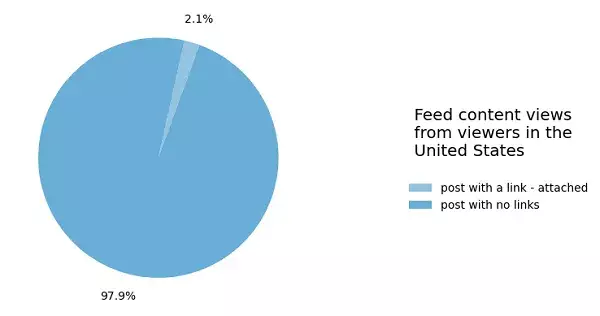In the fast-evolving landscape of social media, understanding user engagement and content violations is paramount. Meta’s recent report on Q4 2024 shines a light on the state of content violations, engagement metrics, and the overall user experience on platforms such as Facebook and Instagram. This analysis reveals essential shifts in user behavior, the challenges facing content creators and publishers, and the potential implications for social discourse.
Meta’s findings reveal a critical trend for publishers attempting to gain traction on Facebook. An astonishing 97.9% of views on Facebook posts in the U.S. did not contain links leading to external sources during the last quarter of 2024. This percentage increased from 86.5% noted in Meta’s first Widely Viewed Content report back in Q3 2021. The rising insularity of the platform indicates that organic referrals from Facebook are diminishing, making it increasingly difficult for publishers to drive traffic to their external websites.
This worrying trend is the result of Meta’s conscious decision to deprioritize links, as part of a broader strategy to move away from news-oriented content. One could speculate that this shift may align with emerging policies that might aim to reintroduce more political discourse on the platform. Regardless of the intentions, the statistics suggest that Facebook has evolved into a space where celebrity gossip and emotional storytelling dominate user engagement, leaving traditional publishers struggling to maintain visibility.
The report also highlights the nature of the content that resonates with Facebook users. The top ten most viewed posts reflect a curious fascination with what one might categorize as “light entertainment.” Posts featuring Christmas celebrations by public figures and heartwarming narratives have become the norm. For example, posts like “Child Asks Santa Claus to Help Mom Instead of Asking For Toys” reflect the type of sugary-sweet narratives that dominate discussions. While such content elicits emotional engagement, it raises questions about the depth and quality of discourse on the platform.
The generic nature of content that gains traction serves as an unspoken guide for marketers and creators: tapping into sentiments and emotions rather than informative or analytical content seems vital for success. This raises concerns about the potential impact on public knowledge and critical thinking, suggesting that platforms may prioritize engagement over educational content.
In terms of content violations, the report observed no significant fluctuations in the prevalence of problematic posts; however, an uptick in violent and graphic content on Instagram was noted, attributed to adjustments in Meta’s proactive detection technology. This situation could lead to a broader conversation about the efficacy of enforcement measures in combating harmful content.
Additionally, Meta reported a decline in fake accounts from 5% to around 3% of its monthly active users on Facebook. While this shift could imply improved detection and management, it opens the door for speculation regarding the methods behind such calculation changes. The reduction could simply reflect Meta’s adaptation to criticisms rather than a fundamental improvement in content quality.
Moreover, the report highlights a transition towards a Community Notes model, replacing third-party fact-checking with greater reliance on user-generated feedback. Although this may initially appear beneficial, one must question whether this will truly enhance the platform’s reliability or further complicate the challenge of misinformation.
Meta’s insights into external threat activity also offer a glimpse into ongoing geopolitical challenges. A notable Russian influence operation, dubbed “Doppleganger,” has altered its targeting strategy, now focusing more on Europe than the U.S. and Ukraine. This shift in approach raises alarms about the evolving nature of misinformation campaigns and their adaptability in response to changing global dynamics.
As social media platforms grapple with the dual challenges of engagement and safety, Meta’s report serves as a critical tool for understanding the current state of its platforms. Continuous monitoring of these shifts will aid in assessing user behavior, potential content violations, and overall safety concerns.
The landscape outlined in Meta’s Q4 2024 report paints a complex picture. As engagement habits shift toward emotionally driven, less informative content, and enforcement strategies adapt to emerging challenges, a pressing conversation about the role of social media in disseminating quality information arises.
While Meta’s initiative towards transparency is commendable, ongoing evaluation of user behavior, content quality, and policy effectiveness remains crucial for the health of online discourse. As such, both content creators and consumers must navigate this evolving landscape with caution, striving to foster a more balanced and informed community on social media platforms.

